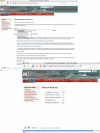The Homeodomain Resource: a comprehensive collection of sequence, structure, interaction, genomic and functional information on the homeodomain protein family
- PMID: 20157477
- PMCID: PMC2790301
- DOI: 10.1093/database/bap004
The Homeodomain Resource: a comprehensive collection of sequence, structure, interaction, genomic and functional information on the homeodomain protein family
Abstract
The Homeodomain Resource is a curated collection of sequence, structure, interaction, genomic and functional information on the homeodomain family. The current version builds upon previous versions by the addition of new, complete sets of homeodomain sequences from fully sequenced genomes, the expansion of existing curated homeodomain information and the improvement of data accessibility through better search tools and more complete data integration. This release contains 1534 full-length homeodomain-containing sequences, 93 experimentally derived homeodomain structures, 101 homeodomain protein-protein interactions, 107 homeodomain DNA-binding sites and 206 homeodomain proteins implicated in human genetic disorders.Database URL: The Homeodomain Resource is freely available and can be accessed at http://research.nhgri.nih.gov/homeodomain/
Figures



Similar articles
-
The Homeodomain Resource: 2003 update.Nucleic Acids Res. 2003 Jan 1;31(1):304-6. doi: 10.1093/nar/gkg118. Nucleic Acids Res. 2003. PMID: 12520008 Free PMC article.
-
The Homeodomain Resource: sequences, structures, DNA binding sites and genomic information.Nucleic Acids Res. 2001 Jan 1;29(1):291-3. doi: 10.1093/nar/29.1.291. Nucleic Acids Res. 2001. PMID: 11125116 Free PMC article.
-
The homeodomain resource: a prototype database for a large protein family.Nucleic Acids Res. 2000 Jan 1;28(1):329-30. doi: 10.1093/nar/28.1.329. Nucleic Acids Res. 2000. PMID: 10592263 Free PMC article.
-
The Homeodomain Resource: sequences, structures and genomic information.Nucleic Acids Res. 1999 Jan 1;27(1):336-7. doi: 10.1093/nar/27.1.336. Nucleic Acids Res. 1999. PMID: 9847220 Free PMC article.
-
A Web-based classification system of DNA-binding protein families.Protein Eng. 2001 Jul;14(7):465-72. doi: 10.1093/protein/14.7.465. Protein Eng. 2001. PMID: 11522919
Cited by
-
Twist-1 is upregulated by NSD2 and contributes to tumour dissemination and an epithelial-mesenchymal transition-like gene expression signature in t(4;14)-positive multiple myeloma.Cancer Lett. 2020 Apr 10;475:99-108. doi: 10.1016/j.canlet.2020.01.040. Epub 2020 Jan 31. Cancer Lett. 2020. PMID: 32014459 Free PMC article.
-
Disruption of aryl hydrocarbon receptor homeostatic levels during embryonic stem cell differentiation alters expression of homeobox transcription factors that control cardiomyogenesis.Environ Health Perspect. 2013 Nov-Dec;121(11-12):1334-43. doi: 10.1289/ehp.1307297. Epub 2013 Sep 20. Environ Health Perspect. 2013. PMID: 24058054 Free PMC article.
-
Characterisation of transcription factor profiles in polycystic kidney disease (PKD): identification and validation of STAT3 and RUNX1 in the injury/repair response and PKD progression.J Mol Med (Berl). 2019 Dec;97(12):1643-1656. doi: 10.1007/s00109-019-01852-3. Epub 2019 Nov 26. J Mol Med (Berl). 2019. PMID: 31773180 Free PMC article.
-
Establishment and analysis of a reference transcriptome for Spodoptera frugiperda.BMC Genomics. 2014 Aug 23;15(1):704. doi: 10.1186/1471-2164-15-704. BMC Genomics. 2014. PMID: 25149648 Free PMC article.
-
Identification of a potential homeodomain-like gene governing leaf size and venation architecture in birch.Front Plant Sci. 2025 Jan 8;15:1502569. doi: 10.3389/fpls.2024.1502569. eCollection 2024. Front Plant Sci. 2025. PMID: 39845490 Free PMC article.
References
-
- Gehring WJ, Affolter M, Burglin T. Homeodomain proteins. Annu. Rev. Biochem. 1994;63:487–526. - PubMed
-
- Dekker N, Cox M, Boelens R, et al. Solution structure of the POU-specific DNA-binding domain of Oct-1. Nature. 1993;362:852–855. - PubMed
-
- Endo T, Ohta K, Saito T, et al. Structure of the rat thyroid transcription factor-1 (TTF-1) gene. Biochem. Biophys. Res. Commun. 1994;204:1358–1363. - PubMed
-
- Kissinger CR, Liu BS, Martin-Blanco E, et al. Crystal structure of an engrailed homeodomain-DNA complex at 2.8 A resolution: a framework for understanding homeodomain-DNA interactions. Cell. 1990;63:579–590. - PubMed
LinkOut - more resources
Full Text Sources

